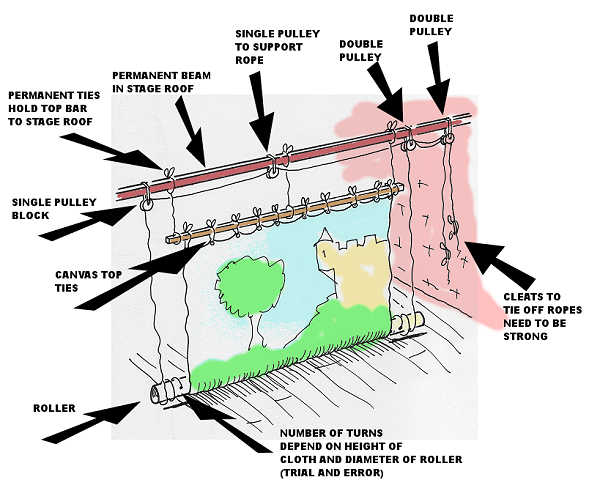And here's another query, this time from Laura in Ontario, CANADA.
We are planning a pantomime this spring. ...We are very naive about backdrops. What kind of material do you use to paint on? How do you change the backdrops quickly?
Hello Laura,
Well some of the elements of your queries I have answered on the previous
page to Chris. So read that in conjunction with this letter to you and
out of it will come (hopefully) some ideas.
MATERIAL I use canvas which I buy from a theatrical
supplier. This material comes off the loom at 9 feet wide and any length.
It is surprisingly cheap bought this way. However if you need a bigger
piece then the price rockets as the separate sections have to be sewn
together.
However, the problem with me advising you is the definition of words.
It is called “canvas” in this country (UK) but it might come
under a different name in Canada. I have a suspicion, for instance, it
might be called “Muslin” in the USA.
When ordering a theatrical canvas you can ask for “Ties” to be attached to the top edge of the cloth. These are lengths of strong webbing spaced about a foot apart and used to tie on the top bar/batten. With a small cloth I usually don’t bother with these ties but instead staple the cloth directly on to the batten.
If the cloth is to be “Flown” (See below) then you can also ask for a “Chain Pocket”. This is a hem which runs the full length of the bottom of the cloth through which you permanently thread a heavy chain which helps to weigh the cloth down and helps it hang straight.
By the way if it is only a simple, small (cheap - no money!) Show I have been known to use ordinary bed sheets instead of canvas. See my "Christmas Carol" page (Close separate window once finished with)
See previous page about sealing the material.
HOW TO CHANGE QUICKLY. In many professional theatres this is easily done by “flying” the cloth straight up, out of sight, into a “Fly Tower” which is a void above the stage . But for us amateurs without this facility it is usually done by rolling up the cloth.
Each canvas Backcloth (sometimes called a Drop Cloth or Backdrop) will have a permanent length of wood attached to the top. However some companies use a metal bar instead of a wooden beam. In fact some countries insist on a metal bar to comply with local fire regulations.
As will be seen from the previous page, the roller along the bottom causes problems and I list some of the problems and some of the solutions. And as I said in the previous page the ropes are wound around the roller so that it unwinds as the roller is wound up. Note the rope goes around the front of the roller
I'll end with a drawing which hopefully will explain the whole set-up.
Best of luck with your Panto.
